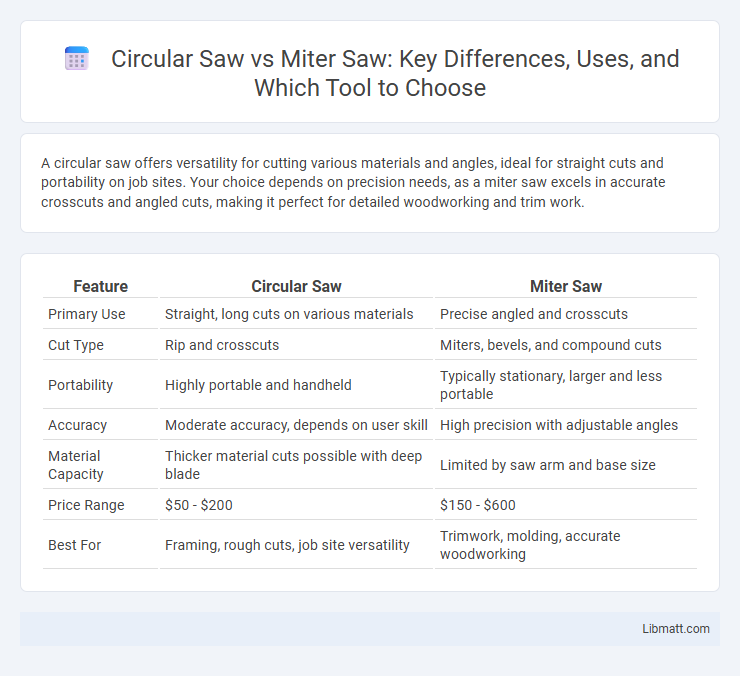A circular saw offers versatility for cutting various materials and angles, ideal for straight cuts and portability on job sites. Your choice depends on precision needs, as a miter saw excels in accurate crosscuts and angled cuts, making it perfect for detailed woodworking and trim work.
Table of Comparison
| Feature | Circular Saw | Miter Saw |
|---|---|---|
| Primary Use | Straight, long cuts on various materials | Precise angled and crosscuts |
| Cut Type | Rip and crosscuts | Miters, bevels, and compound cuts |
| Portability | Highly portable and handheld | Typically stationary, larger and less portable |
| Accuracy | Moderate accuracy, depends on user skill | High precision with adjustable angles |
| Material Capacity | Thicker material cuts possible with deep blade | Limited by saw arm and base size |
| Price Range | $50 - $200 | $150 - $600 |
| Best For | Framing, rough cuts, job site versatility | Trimwork, molding, accurate woodworking |
Introduction to Circular Saw and Miter Saw
Circular saws feature a handheld design with a rotating blade ideal for making straight cuts in wood, metal, or plastic, offering portability and versatility for various construction tasks. Miter saws come with a mounted blade capable of precise angled cuts, primarily used for framing, molding, and trim work requiring accuracy and repetitive cuts. Understanding each saw's purpose enhances tool selection for specific woodworking and carpentry projects based on cut type and precision needs.
Design and Functionality Comparison
A circular saw features a handheld design with a rotating blade suited for straight cuts on various materials, offering portability and versatility. In contrast, a miter saw has a stationary base with a pivoting arm that allows precise angled cuts, ideal for molding, framing, and trim work. Your choice depends on whether you prioritize maneuverability and general cutting or accuracy and specialized angle cuts.
Types of Cuts: Versatility and Precision
A circular saw offers great versatility with its ability to perform rip, cross, and bevel cuts, making it suitable for a wide range of cutting tasks on various materials. A miter saw excels in precision, delivering accurate angled cuts, such as miters and bevels, ideal for framing and molding projects where exact measurements are crucial. Choosing the right saw depends on whether your priority is your need for broad cutting capabilities or pinpoint accuracy in your woodworking projects.
Ease of Use and User Experience
Circular saws offer versatility and portability, making them ideal for cutting large sheets and various materials with straightforward operation. Miter saws provide precise angle cuts and enhanced stability through a fixed base and adjustable fence, improving accuracy and user comfort for repetitive tasks. Users often find miter saws easier for detailed trim work due to their controlled, guided cutting mechanism.
Portability and Storage Differences
Circular saws offer superior portability due to their lightweight, handheld design, making them ideal for on-the-go projects and easy storage in compact spaces. Miter saws, typically heavier and bulkier with a fixed base, demand more dedicated storage and transport effort. If your work requires mobility and quick setup, a circular saw better suits your needs, while a miter saw excels in stationary precision tasks.
Blade Size and Cutting Capacity
Circular saws typically feature blade sizes ranging from 4 1/2 inches to 7 1/4 inches, allowing for versatile cutting depths up to 2 1/2 inches on standard lumber. Miter saws commonly use larger blades between 8 inches and 12 inches, offering enhanced cutting capacity for wider and thicker materials, enabling precise crosscuts and angled cuts on boards up to 6 inches thick. The blade size significantly impacts cutting capacity, with miter saws excelling in accuracy and depth for trim and framing applications compared to the more portable and adjustable circular saws.
Safety Features and Considerations
Circular saws feature blade guards that automatically retract during cutting, but require users to maintain a firm grip and proper blade alignment to avoid kickback and injury. Miter saws offer enhanced safety with built-in blade covers, electric brakes that quickly stop blade rotation, and secure clamps to hold materials steady, reducing the risk of mishandling. Your choice between these tools should consider the safety mechanisms suited to your experience and the precision required for your woodworking projects.
Common Applications for Each Saw
Circular saws excel in making straight cuts on lumber, plywood, and sheet goods, ideal for framing, roofing, and basic construction tasks. Miter saws specialize in precise angled cuts, perfect for molding, trim work, and crafting frames where accuracy is critical. Your choice depends on whether you prioritize versatility and portability with a circular saw or fine, repeatable crosscuts with a miter saw.
Price Range and Value for Money
Circular saws generally offer a lower price range, starting around $50 to $150, making them a budget-friendly choice for versatile cutting tasks. Miter saws, priced between $150 and $600 or more, provide specialized precision for angled cuts, delivering greater value for money in woodworking projects requiring accuracy. Your decision should weigh upfront cost against the specific cutting needs and long-term durability of each saw type.
How to Choose the Right Saw for Your Needs
Choosing the right saw depends on your specific woodworking tasks and project requirements. A circular saw offers versatility for cutting large sheets and straight cuts, ideal for framing or ripping lumber, while a miter saw excels at precision crosscuts and angled cuts, perfect for molding, trim, and detailed carpentry. Consider the type of cuts, materials, and portability to ensure your saw matches your project's demands and enhances your efficiency.
Circular saw vs miter saw Infographic

 libmatt.com
libmatt.com